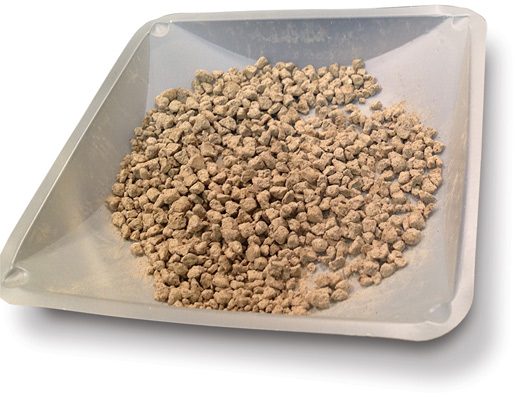Manure-sourced P fertilizer increases crop safety
Key Practice: Struvite shows promise as a phosphorus-fertilizer source. This study shows that struvite recovered from hog manure can match yields compared to monoammonium phosphate and provides higher seed-placed safety.
Project title, Lead Researcher: “Can slow-release monoammonium phosphate and struvite improve phosphorus use efficiency and reduce seedling toxicity in canola?” Francis Zvomuya, University of Manitoba
Grower Organization Funder: ACPC, MCGA, SaskCanola
Struvite, a highly concentrated source of phosphorus removed from hog manure, can be used as a fertilizer to provide a slow-release source of phosphate that increases crop uptake compared to monoammonium phosphate (MAP). The slow release can allow for higher rates of seed-placed phosphate.
This study used greenhouse pot experiments to evaluate the effect of struvite on dry matter yield (which correlates to grain yield) and growth room experiments to assess canola seedling toxicity from seed-placed struvite. Experiments were repeated on a Dark Grey sand soil and a Black clay-loam soil. Struvite was compared to MAP and a polymer-coated slow-release MAP at two rates corresponding to 25 and 50 kg/ha of phosphate.
The pot experiments included two separate crop sequences in the same pots: canola-wheat-canola and wheat-canola-wheat. Pot studies found a signifi-
cant response to all three phosphorus sources when compared to the check treatment with no phosphate, but only for the first crop in the rotation. Struvite produced dry matter canola yields similar to MAP in that first crop.
At the high rate (equivalent to 50 kg/ha of phosphate), struvite out-yielded standard MAP in the second crop and both MAP sources in the third crop. Across soils and placement methods, doubling the rate of struvite and standard MAP improved dry matter yield, but rate of polymer-coated MAP did not have a significant effect on yield.Seed-placed struvite and the polymer-
coated MAP did not reduce seedling emergence when increased to the higher rate. The higher rate of standard MAP reduced seedling emergence in the Black clay loam soil by over 50 percent.
Results from this study indicate great potential for struvite from hog manure to be an effective phosphorus source for both canola and wheat. It could be a viable alternative to MAP, and it can be safely applied in the seed-row at higher rates than MAP.
Struvite also contains nitrogen, magnesium and smaller amounts of calcium and potash.
In addition to the agronomic benefits for canola producers, recovery of struvite from hog manure could be a sustainable way of recycling phosphate from livestock operations coming under increasing regulatory pressure to curb the application of high-phosphate manure.
| Analyte | Struvite | MAP | CMAP |
| g kg (air-dry basis) | |||
| Total N | 57.7 | 110 | 110 |
| Ammonium N | 16 | 110 | 110 |
| Total P (P2O5) | 230 | 520 | 520 |
| K2O | 4.4 | — | — |
| Ca | 5 | — | — |
| Mg | 64 | — | — |
| pH | 5.5 | 4.8 | 4.8 |
| Moisture (%) | 40 | 1.2 | 1.2 |
| MAP is monoammonium phosphate (11-52-0) and CMAP is polymer-coated MAP. | |||





